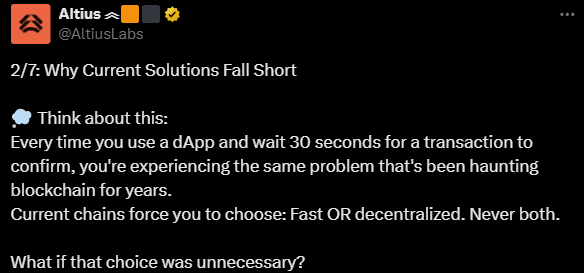Web3 is no longer a novel concept, but it is being hindered by an inherent issue: speed. Current blockchains often cannot meet the needs of real-world users without sacrificing decentralization or increasing the risk of system failure.
Recently, Altius Labs made a post on X that sheds light on this issue, emphasizing that the execution layer is the 'final boss' that needs to be addressed to take Web3 further. My blog will analyze why the execution layer is key to unlocking the potential of Web3 and how Altius is shaping the future of blockchain.
Core Issue: Web3 Too Slow
As Altius pointed out, every time you use a decentralized application and have to wait 30 seconds for a transaction to be confirmed, you are facing a persistent blockchain issue: low performance.
Current blockchains force users to choose between speed and decentralization. Want fast transactions? You must accept centralized solutions or high gas fees. Want to maintain decentralization? You have to endure long delays and low throughput.
Altius stated on X:
"Current chains force you to choose: Fast OR decentralized. Never both. What if that choice was unnecessary?"

This is not just a challenge but also a promise from Altius: a solution where speed and decentralization can coexist.
The Modular Revolution: Separate to Optimize
One of Altius's main arguments is the importance of a modular blockchain architecture. Instead of a blockchain trying to do everything from consensus, data storage to execution, Altius proposes separating these components:
- Execution Layer: Handling smart contract execution.
- Data Availability Layer: Ensuring data is available and transparent.
- Consensus Layer: Managing agreement among nodes.
By optimizing each component for its specific task, Altius achieves superior performance compared to monolithic blockchain designs. This not only improves throughput and reduces latency but also makes it easier for blockchains to upgrade without changing the entire system.
The multi-chain world: A maze that needs replacing
The current blockchain world faces a serious issue: fragmentation. Each new blockchain brings:
- Bridges are vulnerable to attacks, increasing security risks.
- Fragmented liquidity, reducing the effectiveness of DeFi applications.
- Developer fatigue, as they have to rebuild dApps for each chain.
- Complex user experience, with different wallets and interfaces on each chain.
Altius calls this a maze and believes the solution is not to create more blockchains, but to build a better execution layer. Instead of adding new chains, Altius focuses on optimizing the execution layer to create a 'highway' for Web3, where transactions occur smoothly and securely across multiple chains.
The impossible triangle of blockchain: Can it be broken?
The blockchain trilemma has become a widely accepted principle: you can only achieve two out of three factors: speed, security, or decentralization. However, Altius questions:
"What if the problem isn’t the trilemma—it’s how we’re approaching execution?"
By reshaping the execution layer, Altius aims to break this impossible triangle. Their core technology, which includes Parallel Scalable Storage (PSS), Instruction-Level Parallelism (ILP), and Application Code Assessor (ACA), enables parallel processing, reduces conflicts, and optimizes performance without sacrificing decentralization.
VM-Agnostic advantage
A standout feature of Altius is its VM-agnostic capability. Traditional blockchains are often locked into a single virtual machine, such as EVM (Ethereum Virtual Machine). If you want to use a different virtual machine like MoveVM or CosmWasm, you have to build an entirely new chain.
Altius changes this by providing a plug-and-play execution layer that supports multiple virtual machines such as:
- EVM (Ethereum and EVM-based Layer 2s).
- MoveVM (Aptos, Sui).
- CosmWasm (Cosmos).
- General WASM, zkVM, and BitVM.
This allows developers to use the virtual machine that best suits their needs without having to create a new chain, while ensuring cross-chain interoperability without vulnerable bridges.
The future of Web3: Instant transactions, low fees, smooth experience
Altius paints a promising picture for Web3:
- Instant transaction confirmation: Latency under 100ms, comparable to Web2 experience.
- Super low gas fees: Just a few cents per transaction.
- Multi-chain compatibility: Any virtual machine, any chain, operates seamlessly.
- No need to choose between speed and security: High performance goes hand in hand with decentralization.
This is not science fiction. Altius is building an execution layer from scratch, aiming for 1–2 Giga gas per second and supporting tens of thousands of transactions per second, equivalent to the speed of Visa/Mastercard, while still maintaining decentralization and composability.
Web3 is not too early, but it is too slow. Altius is leading the way in addressing this issue by reshaping the execution layer, delivering speed, scalability, and interoperability without sacrificing decentralization. As their post on X emphasized:
"The question isn’t IF—it’s WHEN."
Follow Altius's journey for the latest updates on their progress in shaping the future of Web3.